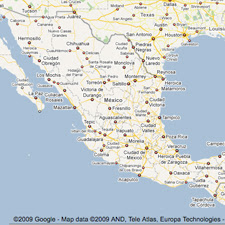A pice of Mexican history
Mexico
Mexico
After more than 10 years of war and centuries of Spanish dominance dating to conquest by Hernán Cortés and the conquistadors, Mexico won independence in 1821. Since then, its history has been linked closely with that of the U.S. and it is now the U.S.’s leading trading partner. However, Mexico is plagued by drug related violence and a highly unequal distribution of wealth.
Timeline of Major Events
1821 Spain recognizes Mexico's independence.
1848 Mexico cedes half of its territory to the United States in the Treaty of Guadeloupe Hidalgo.
1910 Unrest amongst peasants and urban workers leads to the Epic Revolution.
1911 Mexico's dictator, Porfirio Diaz, is overthrown.
1920 The President of Mexico is murdered. Civil war follows.
1929 The National Revolutionary Party is formed. Later renamed the Institutional Revolutionary Party (PRI).
1968 Student demonstration in Mexico City over unequal distribution of wealth is violently suppressed by Mexican security forces.
1976 Huge offshore oil reserves are discovered.
1994
The Zapatista National Liberation Army leads a guerilla rebellion in Chiapas, which is brutally suppressed by government troops.
The stock market plunges and the peso loses a third of its value.
1996 The insurgency in the south escalates. The Popular Revolutionary Army (EPR) attacks government troops.
2006
Special prosecutor appointed to tackle issue of violent crime against women.
US President George W. Bush signs legislation intended to curb illegal immigration by constructing 700 miles of fencing along the US-Mexico border. Mexico condems the plan.
2008
http://www.globalgoodspartners.org/cart/results.cfm?country=242&gclid=CPf86ofdsrcCFWNxQgodrl4AWg
The number of drug-related killings soars. More than 4,000 people have been killed in drug-related violence since President Calderon took office two years prior.
 Economic Indicators
51.3% of the population lives below the poverty line.
44% of women participate in the labor force.
Mexico’s economy is the 12th largest in the world and the nation is a leading producer of oil. Improvements in the women’s labor force have translated into small economic gains, however half the number of women employed is half that of men and so a large gender-based wage gap still exists.
Vulnerable Populations
Income distribution is highly unequal in Mexico – poor urban populations live in hazardous conditions, and poor rural populations suffer from isolation and have few income opportunities.
The indigenous populations of Mexico have long suffered economic, political and social marginalization. Comprising between 12% and 30% of the population, indigenous groups maintain the lowest life expectancies and highest infant mortality rates in the country.
Public Health Concerns
Since 2006 over 10,000 people have died as a result of drug related violence. As a consequence of poverty and drug-related instability, approximately 400,000 Mexicans immigrate to the United States in search of jobs each year, at great personal risk.
Economic Indicators
51.3% of the population lives below the poverty line.
44% of women participate in the labor force.
Mexico’s economy is the 12th largest in the world and the nation is a leading producer of oil. Improvements in the women’s labor force have translated into small economic gains, however half the number of women employed is half that of men and so a large gender-based wage gap still exists.
Vulnerable Populations
Income distribution is highly unequal in Mexico – poor urban populations live in hazardous conditions, and poor rural populations suffer from isolation and have few income opportunities.
The indigenous populations of Mexico have long suffered economic, political and social marginalization. Comprising between 12% and 30% of the population, indigenous groups maintain the lowest life expectancies and highest infant mortality rates in the country.
Public Health Concerns
Since 2006 over 10,000 people have died as a result of drug related violence. As a consequence of poverty and drug-related instability, approximately 400,000 Mexicans immigrate to the United States in search of jobs each year, at great personal risk.
 Economic Indicators
51.3% of the population lives below the poverty line.
44% of women participate in the labor force.
Mexico’s economy is the 12th largest in the world and the nation is a leading producer of oil. Improvements in the women’s labor force have translated into small economic gains, however half the number of women employed is half that of men and so a large gender-based wage gap still exists.
Vulnerable Populations
Income distribution is highly unequal in Mexico – poor urban populations live in hazardous conditions, and poor rural populations suffer from isolation and have few income opportunities.
The indigenous populations of Mexico have long suffered economic, political and social marginalization. Comprising between 12% and 30% of the population, indigenous groups maintain the lowest life expectancies and highest infant mortality rates in the country.
Public Health Concerns
Since 2006 over 10,000 people have died as a result of drug related violence. As a consequence of poverty and drug-related instability, approximately 400,000 Mexicans immigrate to the United States in search of jobs each year, at great personal risk.
Economic Indicators
51.3% of the population lives below the poverty line.
44% of women participate in the labor force.
Mexico’s economy is the 12th largest in the world and the nation is a leading producer of oil. Improvements in the women’s labor force have translated into small economic gains, however half the number of women employed is half that of men and so a large gender-based wage gap still exists.
Vulnerable Populations
Income distribution is highly unequal in Mexico – poor urban populations live in hazardous conditions, and poor rural populations suffer from isolation and have few income opportunities.
The indigenous populations of Mexico have long suffered economic, political and social marginalization. Comprising between 12% and 30% of the population, indigenous groups maintain the lowest life expectancies and highest infant mortality rates in the country.
Public Health Concerns
Since 2006 over 10,000 people have died as a result of drug related violence. As a consequence of poverty and drug-related instability, approximately 400,000 Mexicans immigrate to the United States in search of jobs each year, at great personal risk.
